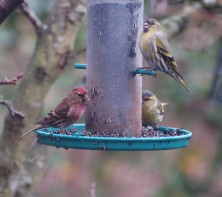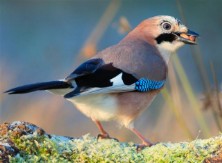April 2021
Bird Sightings

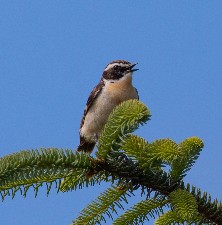
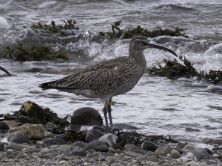
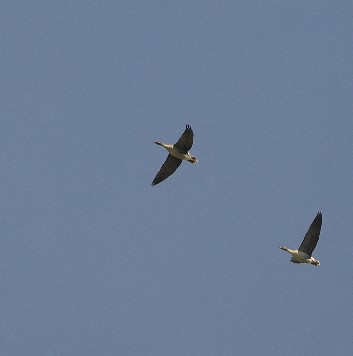
April is the month when spring migration gets underway, with arrivals and departures of birds, all seeking their best breeding territories. This April was very dry with no measurable rain on more than twenty days. With a predominance of northerly winds April was colder than March and the mean temperature was more than two degrees lower than last April. . The impact on migrating birds of the weather here and throughout their route is difficult to know, but even by the end of the month the bulk of the migrants had still to arrive.
By the end of March, the first Chiffchaff, White Wagtail, Wheatear and Sand Martin had been reported. Here are April “firsts” with the 2020 arrival date in brackets for comparison: Willow Warbler 2nd(5th), Manx Shearwater 2nd(28th March), Sandwich Tern 2nd(6th), Common Sandpiper 2nd(10th), Swallow 2nd(5th), House Martin 5th(4th), Cuckoo 14th(14th), Grasshopper Warbler 19th(19th), Whinchat 21st(22nd), Whitethroat 22nd(16th), Sedge Warbler 23rd(18th) and Tree Pipit 27th(18th).
In April some of our wintering birds were still around, including seven Teal at Kilpatrick Point on 2nd, one hundred and thirty-five Greylag Geese in the Shiskine Valley on 3rd, four Wigeon at Cosyden also on 3rd, twenty-five Fieldfare at Sliddery also on 3rd, one Merlin at Machrie Golf course on 15th, three Rook at Sliddery on 23rd and one Whooper Swan on Sliddery Shore on 27th. The last report of Pink-footed Geese was one hundred and twenty flying north over Cleats Shore on migration on 15th.
April is an ideal time for watching migration. These are a few examples: twenty Skylark on Cleats Shore on 2nd, fourteen Twite also on Cleats Shore on 2nd, five Great Northern Diver off Pladda on 3rd, one Bar-tailed Godwit on Sliddery Shore also on 3rd, forty-five Golden Plover at Machriewaterfoot on 15th, twenty Turnstone also at Machriewaterfoot on 15th, fifty Linnet at Sliddery on 23rd, a Dunlin on Silver Sands on 24th and thirty-one Whimbrel at Porta Buidhe on 27th. One of these Whimbrel had been ringed on a southern Arran shore in 2017. It was reported yet again almost on the same shore, for the fourth year in a row, having again spent the winter in Africa! In addition, the Little Egret first reported in October and the Nuthatch also first reported in October both seem to have left the island after over-wintering. The last Little Egret report was from Clauchlands on 16th and the Nuthatch seems to have left Pirnmill on 1st and spent a few days in Dippin before leaving there on 6th.
Migration was also in evidence from the widespread reports received of Goldfinch and Siskin moving through people's gardens throughout the month. Larger garden numbers reported included forty Goldfinch at Shannochie on 4th and eleven Siskin at Strathwillan on 11th. In addition, there were widespread reports of Lesser Redpoll at garden feeders including four at Lagg on 27th. Tens of thousands of birds seem to be moving through the island at this time of year.
In April there were over one hundred and ten species recorded on Arran. Here is a further small selection from this list: ten Shelduck at Port na Feannaiche on 3rd, an Osprey in the Shiskine Valley on 15th, three Puffin in Brodick Bay on 23rd, a Jay at Port na Lochan on 24th (last Arran record 2012), a Water Rail at Feorline on 26th and twelve Gannet in Machrie Bay on 27th. The highlight in April was the Rough-legged Buzzard seen by the Ross Road near Glenree on 25th, the first Arran record since 1974. It featured in a recent “Banner” Bird Note.
From a birding point of view, May should be an equally interesting month with the arrival of more summer visitors including Garden Warbler, Lesser Whitethroat, Wood Warbler, Swift, Arctic Tern and hopefully, even Corncrake and Nightjar.
Finally, spring is a great time to be birding, as most birds are getting on with the business of breeding. The business of breeding involves attracting a mate by song, courtship display and ritual, defining a territory, nest building, and generally establishing relationships. Please take a moment to report any signs of breeding birds to me. Already there have been reports of Blue Tits nest building, Robins feeding young, Blackbirds carrying food and Mallard with young. Interestingly there were reports from two locations of Yellowhammer singing. I wonder if the birds are just passing through or if they will stay to breed? If they do it will be the first time since 1999.
Please remember that under the Nature Conservation (Scotland) Act 2004 it is an offence to intentionally or recklessly damage or destroy the nest of any wild bird while it is being built or used. Take particular care on our shores and beaches and please keep your dogs on a lead at this time.
